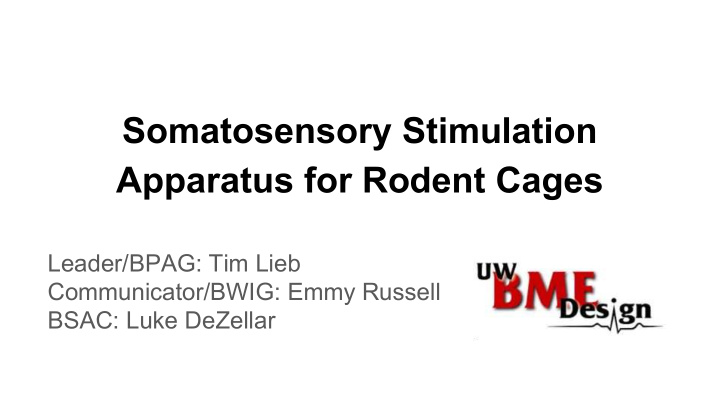



Somatosensory Stimulation Apparatus for Rodent Cages Leader/BPAG: Tim Lieb Communicator/BWIG: Emmy Russell BSAC: Luke DeZellar
Client: Dr. Aaron Dingle, Department of Surgery Advisor: Prof. Mitch Tyler, Department of Biomedical Engineering
Overview: ● Project Relevance ● Problem Statement ● Physiological Background ● Product Design Specifications ● Stimulation Modalities Considered ● Vibration Source Designs/ Design Matrix ● Cage-Motor Interface Designs/ Design Matrix ● Final Design ● Future Work ● References & Acknowledgments
Project Relevance ● 185,000 amputee surgeries per year in US [1] ○ 42.2-78.8% of amputees suffer from phantom limb pain [2] ● Dr. Dingle designing an electronic interface for peripheral nerves ○ Electrode allows prosthetics to restore sense of touch and relieve pain ○ Currently in need of method for testing device in rat models ● Current plan for rat testing: ○ Train healthy rat to respond to somatosensory stimulus on hindlimbs ○ Amputate hindlimb and implant device ○ Stimulate hindlimbs with electrode and observe if rat responds the same way
Problem Statement ● Design device to provide somatosensory stimulus to rat hindlimbs ○ Provide graded stimulus to each hindlimb individually ○ Include microcontroller to control stimulation ● Device must include cage to train rat ○ Cage must not limit rat’s ability to respond to stimulus
Physiological Background ● Somatosensory system: System of neurons connecting peripherals to brain ● Merkel cells ○ Mechanoreceptors in skin ○ Sense low frequency vibrations 5-15Hz [3] ● Tactile corpuscles ○ Mechanoreceptors in skin ○ Sense 10-50Hz frequencies [3] http://www.napavalley.edu/people/briddell/Doc uments/.../_START_HERE_ch09_lecture.ppt
Product Design Specifications ● Provide stimulation to the rat’s hindlimbs. Stimulation must ○ Be isolated to the individual limbs ○ Not interfere with the electrode therapy ○ Allow for varying frequencies ● The cage can not limit the rat’s mobility and ability to respond to the stimulation ● Cage dimensions: 10 in x 11 in x 12 in ○ Must weigh under 5 lbs to allow for easy storage and use ○ Clear polycarbonate walls
Stimulation Modalities Considered ● Electrical Stimulation ○ Too similar to Dr. Dingle’s electrodes ● Temperature Stimulation ○ Not instantaneous ○ Potential to harm rat ● Pressure Stimulation ○ Not instantaneous ○ Movement restriction ● Vibration Cuffs ○ Movement restriction http://www.noldus.com/EthoVision-XT/Rat-Behavior-Recognition
Vibration Source Designs Speaker Solenoid Actuator Motor https://www.sparkfun.com/products/9151 http://www.voodooguitar.net/2016/11/everything-y https://www.digikey.com/product-detail/en/sparkfun ou-ever-wanted-to-know_14.html. -electronics/ROB-11015/1568-1592-ND/6163694
Design Matrix: Vibration Sources
Cage-Motor Interface Designs Connected Disconnected
Design Matrix: Cage - Motor Interface
Final Design ● Speaker actuators combined with the connected interface ● System diagram show the electrical components
Future Work ● Decide on specific components to use ○ Speaker actuator, driver, microcontroller ● Determine how to control the specific frequencies ● Build the prototype ● Test that the output frequencies are correct using accelerometer ○ Goal is within +/- 0.5 Hz
References & Acknowledgements Special thanks to Dr. Amit Nimunkar and Dr. Aaron Suminski for their guidance [1] "Limb Prosthetics Services and Devices", Semantic Scholar , 2017. [Online]. Available: https://pdfs.semanticscholar.org/c3ae/f3563844e2e2835411fcbc2b0fe3091ac30b.pdf. [Accessed: 20- Sep- 2017]. [2] B. Subedi and G. Grossberg, "Phantom Limb Pain: Mechanisms and Treatment Approaches", Pain Research and Treatment , vol. 2011, pp. 1-8, 2011. [3] A. Basbaum, The Senses: A Comprehensive Reference . Oxford, U.K.: Elsevier, 2008, pp. 33-38.
Questions?
Recommend
More recommend